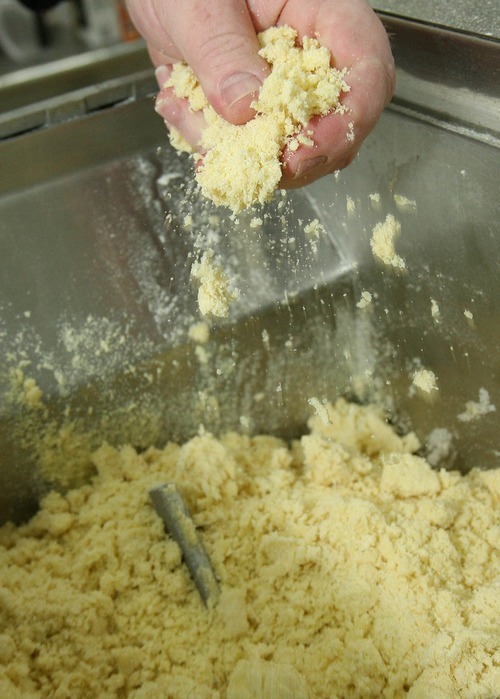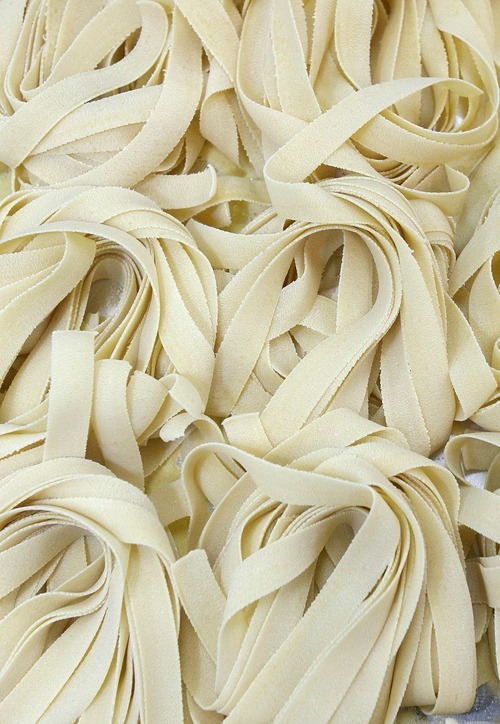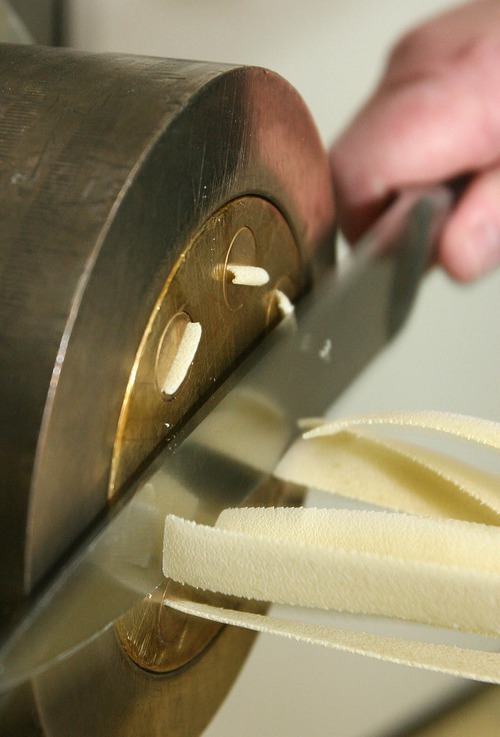This is an archived article that was published on sltrib.com in 2011, and information in the article may be outdated. It is provided only for personal research purposes and may not be reprinted.
Kyle Lore missed the Frontrunner train and had 60 minutes to kill before the next one arrived.
For the next hour, the Utah chef wandered the hallways of Salt Lake City's Intermodal Hub, reading all the historical information about the downtown neighborhood. Included in one of those panels was a kernel of culinary information most people would overlook — but the words put Lore on the artisan pasta-making track.
The story featured the Western Macaroni Manufacturing Co., one of the largest pasta factories in the United States at the turn of the 20th century. The owner, Antonio Ferro, made his Italian-style pasta using flours made from Durum semolina and hard red wheat grown in Utah.
As soon as he read about the wheat, harvested in the state for more than 100 years, Lore said a bell went "ding" in his head.
"Yes! We have good wheat here in Utah," he thought. "We just haven't used it for pasta."
After research and testing, the 45-year-old started Nu Nooz Artisan Pasta company in spring 2010. The company name was inspired by one of Lore's four daughters, when the then-2-year old kept asking her daddy to make noodles, which she called "nu nooz."
Nu Nooz pastas — both dried and fresh — are made with minimal ingredients: enriched Durham semolina flour and that Utah hard red winter wheat flour he read about, as well as Utah's Redmond sea salt and water. Sometimes his fresh pastas also include eggs, and during the Farmer's Market season, he makes seasonal pastas using everything from Utah cheese to pumpkin.
Lore said the hard red wheat, which is grown in Utah and milled at Cache Valley's Central Milling, is the key ingredient. That particular variety has a high level of protein, 15 to 19 percent, compared to the usual 10 percent.
"Protein translates to gluten and gluten is what gives pasta its shape and its springiness," he said.
—
Like the Romans • The equipment that Lore uses also sets him apart from mass-produced pasta makers. Once the dough is made, it's pushed through a bronze extruder — the same metal used by ancient Romans — and cut by hand. The bronze die creates a pasta with a rough surface, which helps it hold sauce and taste better, Lore said.
Conversely, mass-produced pastas are pushed through a plastic form, which leaves a smooth and slippery surface. Commercial pastas also are put through a steaming and heating process that dries it but also partially cooks it.
Lore follows a more artisan path by air-drying his pasta. Utah's dry climate poses a few challenges. But after some trial and error, Lore created a greenhouse-like shell in his Woods Cross factory that closely matches the coastal humidity common in Italy.
Last year, he started selling different varieties of dried and fresh pastas at the downtown Salt Lake City Farmers Market at Pioneer Park. Customers usually had to act quickly if they wanted to buy his hand-made ravioli, as he sold out almost every Saturday. During the past winter his pastas have been available at specialty stores and an indoor farmer's market in Salt Lake City. (A list accompanies this story.)
A native of Colorado, Lore worked in several California restaurants and hotels before moving to Utah about eight years ago. He was the executive chef at a ranch in Moab and was the corporate chef for Harmon's Grocery Stores. He had to quit the post, when his wife, Caren Hale-Koch, job took a job in Denver and the family moved.
When the family returned to Utah about a year later, the recession was in full swing and executive chef jobs were hard to come by. Lore catered and worked temporary chef jobs, but ultimately decided to start his own business. Pasta — something he had made while working in California — was one of the ideas on the list. So was making bamboo-based skateboards and snowboards.
He hadn't decided until that night in the station.
—
Pasta praise • Matt Caputo, owner of Caputo's Market and Deli and an expert on imported Italian goods, has high praise for the Utah-made product. He puts Lore and Nu Nooz Pasta into the same category as Cristiano Creminelli's salami and Art Pollard's Amano Artisan Chocolates. Those two Utah producers have earned accolades nationally and internationally for their quality and attention to detail.
"Like Creminelli and Amano, the food elite will be coming from all around the country to witness his mastery," Caputo predicted about Lore's pasta.
Caputo is not the only one Lore has impressed. Slow Food Utah recent gave Lore an $1,800 grant to buy a larger ravioli-making machine to keep up with customer demand at the Saturday market. And the 9th South Deli in Salt Lake City has started using Nu Nooz for its kugel,
There also are plenty of Utah customers, including 39-year-old Amy Barry, who has sworn off grocery store pasta since discovering Nu Nooz at the Sugar House Farmers Market last summer.
"I love the dried, and the fresh pasta," said the Salt Lake County employee. "During the market, Kyle had seasonal flavors like ancho pumpkin and spinach pesto. They were so fresh you didn't need a sauce for them. I just put on a little olive oil and cheese."
Barry's favorite is the dried spaghetti. "It just tastes lighter and it cooks faster," she said.
Meeting Lore has helped her branch into new varieties, as well. "He sells pasta that I've never heard of before, ones that you can't find in the store," she said. "And it's so much better than what I had been eating."
Martha Wunderli is another regular customer. Originally from New York, Wunderli said when she moved to Utah she struggled to find the fine Italian pastas she enjoyed on the East coast. Her wait is over.
Nu Nooz, she said, "is what good Italian tastes like."
Pasta do's and don'ts
Perfectly cooked pasta requires that you follow a few rules.
Do
Buy • Purchase the best pasta you can afford. It will usually contain semolina made from Durum wheat, and will be hand-cut and air-dried. You'll find it in Italian specialty shops and natural food markets.
Water • Pasta needs to cook in a large pot with a generous amount of water because crowded noodles stick together. For one pound of pasta, use 5 to 6 quarts. The water level should be 3 inches above the pasta while it's cooking.
Salt • Don't be shy with salt, as it will give your pasta flavor. For one pound of pasta, add two tablespoons salt. Stir salt into the boiling water just before adding pasta.
Cooking • Italians like pasta "al dente," which means "to the tooth," or a little chewy. Keep checking the pasta as it cooks, pinching it between your thumb and forefinger. Remove it from the heat when the center still has a slight bit of give. Remember, pasta absorbs heat and will continue to cook after it's drained.
Drain • Drain pasta well.
Finish • Gently fold hot pasta into a tomato or cream sauce to finish cooking.
Don't
Oil • Do not put oil in the cooking water.
Over stir • Give the pasta a gentle swirl every three or four minutes. More than that will make it break apart.
Over cook • Cooking times on packages are only guidelines and will vary, especially in high-altitude regions like Utah. If the package says 6 to 8 minutes, start checking the pasta at 6 minutes.
Rinse • Rinsing pasta after it's cooked washes away the starch that helps the sauce stick.
Source: Kyle Lore, owner of Nu Nooz pasta —
Pasta with oven roasted tomatoes
8 large tomatoes, very ripe*
Coarse sea salt to taste
4 cloves garlic, coarsely chopped
1/2 cup Italian parsley, minced
1/2 cup panko bread crumbs, toasted in a frying pan until lightly golden
1/2 cup extra-virgin olive oil
1 pound air-dried pasta (Nu Nooz brand suggested)
Freshly ground black pepper to taste
1/2 cup fresh basil leaves, shredded
Freshly grated Pecorino cheese
Crushed red chile peppers, to taste, optional
Preheat oven to 425 degrees. Lightly oil a shallow, oven-safe pan or dish. Slice each tomato in half and set, cut side up in a single layer in the dish. Sprinkle with salt, garlic, parsley and toasted bread crumbs. Drizzle with more olive oil. Place in the oven and bake 30 to 45 minutes or until the tomatoes are soft and juicy.
Meanwhile, bring a large pot of water, with salt, to a boil. Add pasta and cook according to package directions. Drain the pasta well and turn into a large bowl. Scrape the tomatoes and all the juice over pasta and mix well. Add more salt and pepper if necessary. Serve with grated cheese and a sprinkle of peppers, if desired.
*Good quality canned tomatoes can be used as a substitute.
Servings • 8
Source: Caputo's Market and Deli, Salt Lake City —
Nu Nooz Artisan Pasta
Where to buy • In Ogden: It's available at Beehive Cheese, 2440 E. 6600 South. In Salt Lake: Caputo's Market and Deli, 314 W. 300 South, Salt Lake City; Caputo's on 15th, 1516 S. 1500 East; Salt Lake City; Cali's Natural Foods, 389 W. 1700 South, Salt Lake City; and 9th South Delicatessen, 931 E. 900 South. Nu Nooz also will be available later this year during the Saturday Downtown Farmers Market, the Sunday People's Market and the Sugarhouse Farmers Market.
What's available • Dried pastas include: fettucine, classic egg noodles; Mafaldine, named in honor of a princess; pappardelle, a broad, thin noodle, which means to gobble up; Monezzagalia, a mix of pastas that can be used for soups and casseroles; spaghetti, both regular and whole-wheat; and teeny rotini and a ridged maccheroni, a relative of macaroni. Fresh pastas vary by the season but include ravioli, tri-color rigatoni, half-moon shaped agnolotti; vermicelli, tagliatelle and cavatelli.
More info • http://www.nunooz.net or call 801-549-7358.















